1997 CHEVROLET CORVETTE change time
[x] Cancel search: change timePage 190 of 356
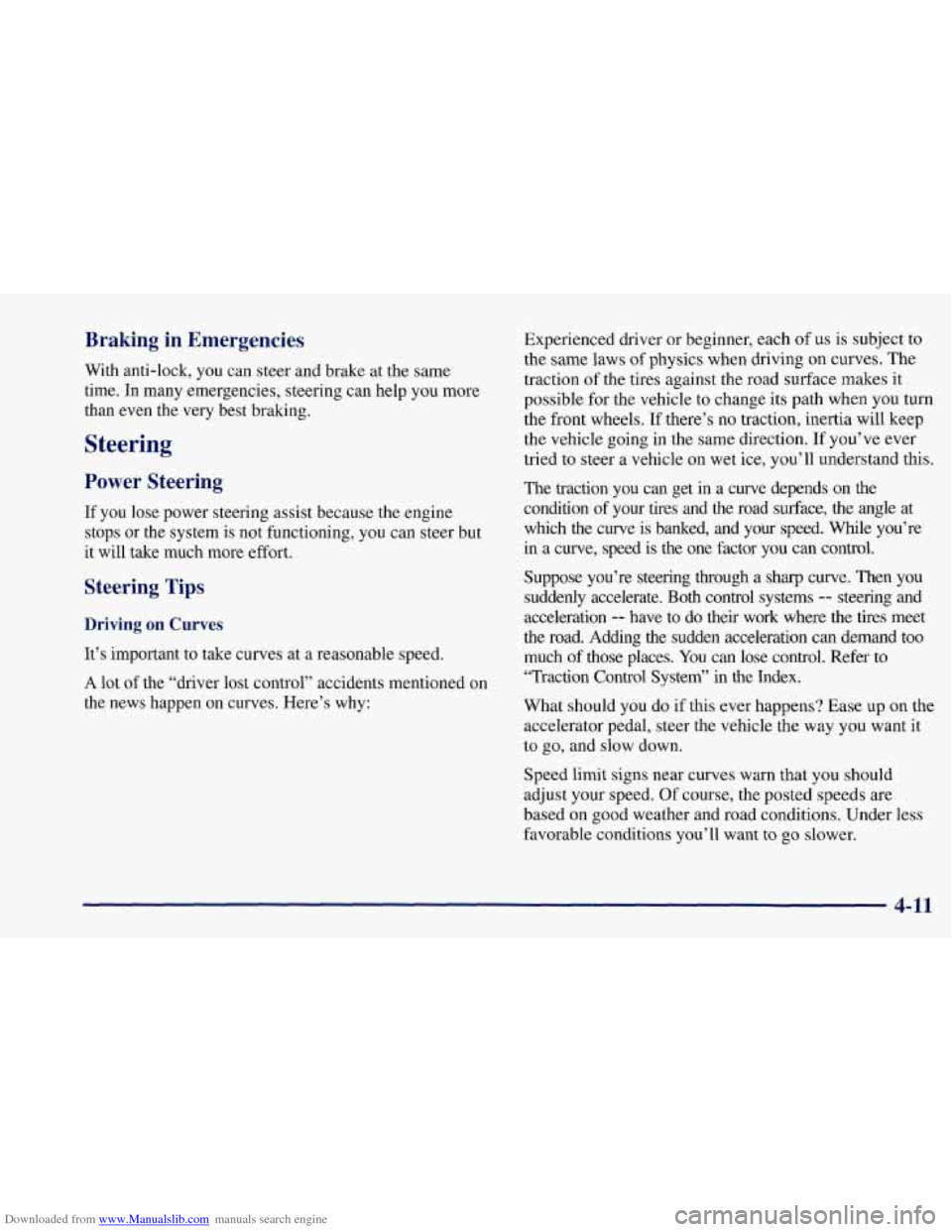
Downloaded from www.Manualslib.com manuals search engine Braking in Emergencies
With anti-lock, you can steer and brake at the same
time. In many emergencies, steering can help you more
than even the very best braking.
Steering
Power Steering
If you lose power steering assist because the engine
stops or the system is not functioning, you can steer but
it will take much more effort.
Steering Tips
Driving on Curves
It’s important to take curves at a reasonable speed.
A lot
of the “driver lost control” accidents mentioned on
the news happen on curves. Here’s why: Experienced driver
or beginner, each
of us is subject to
the same laws
of physics when driving on curves. The
traction
of the tires against the road surface makes it
possible for the vehicle to change its path when you turn
the front wheels. If there’s no traction, inertia will keep
the vehicle going in the same direction. If you’ve ever
tried to steer a vehicle on wet ice, you’ll understand this.
The traction you can get in a curve depends on
the
condition of your tires and the road surface, the angle at
which the curve is banked, and your speed. While you’re
in a curve, speed is the one factor you can control.
Suppose you’re steering through
a sharp curve. Then you
suddenly accelerate. Both control systems
-- steering and
acceleration
-- have to do their work where the tires meet
the road. Adding the sudden acceleration can demand too
much of those places. You can lose control. Refer to
“Traction Control System” in the Index.
What should you do
if this ever happens? Ease up on the
accelerator pedal, steer the vehicle the way you want it
to go, and slow down.
Speed limit signs near curves warn that you should
adjust your speed. Of course, the posted speeds are
based on good weather and road conditions. Under less
favorable conditions you’ll want to
go slower.
4-11
Page 193 of 356
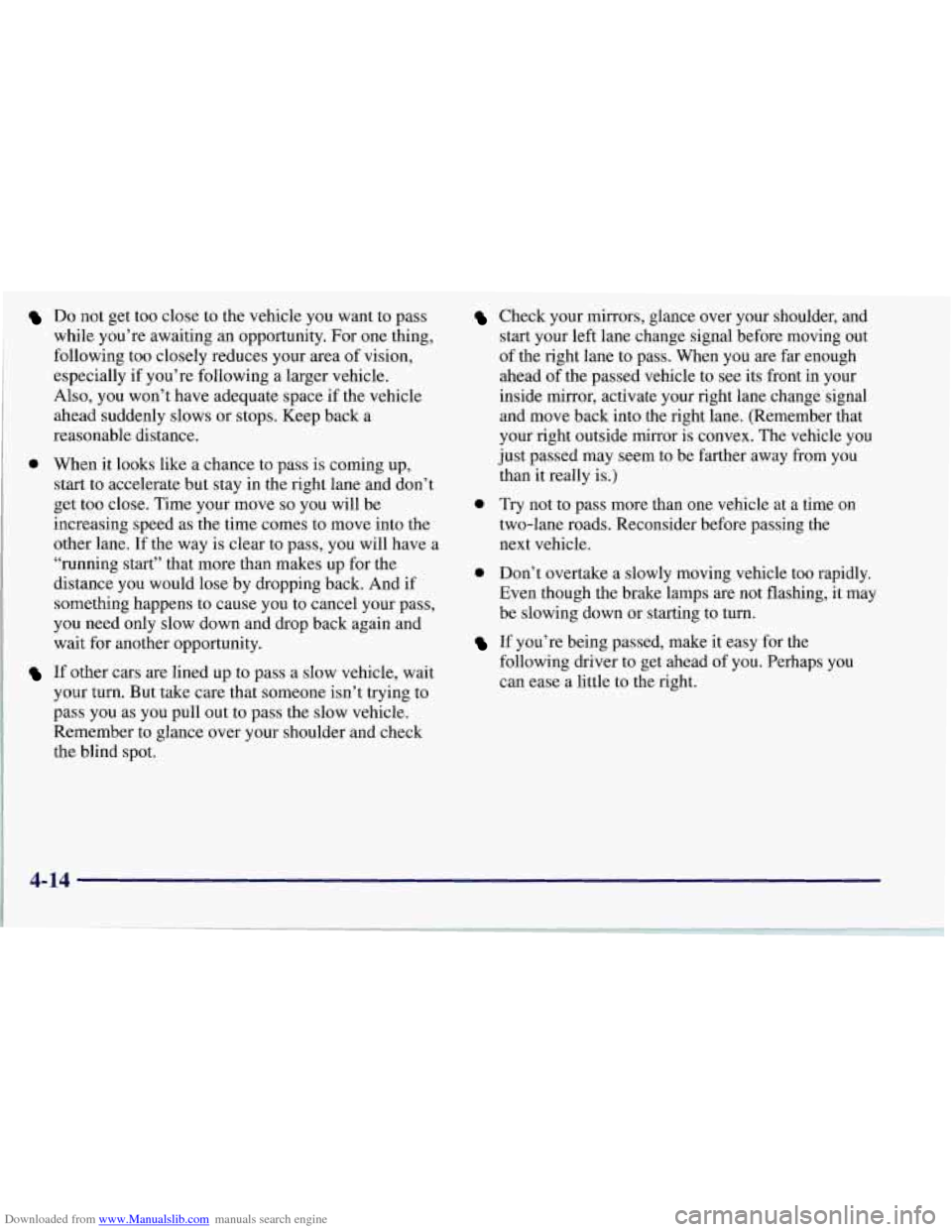
Downloaded from www.Manualslib.com manuals search engine Do not get too close to the vehicle you want to pass
while you’re awaiting an opportunity.
For one thing,
following too closely reduces your area of vision,
especially if you’re following a larger vehicle.
Also, you won’t have adequate space if the vehicle
ahead suddenly slows
or stops. Keep back a
reasonable distance.
0 When it looks like a chance to pass is coming up,
start to accelerate but stay in the right lane and don’t
get too close. Time your move
so you will be
increasing speed as the time comes to move into the
other lane. If the way
is clear to pass, you will have a
“running start” that more than makes up for the
distance you would lose by dropping back. And if
something happens to cause you to cancel your pass,
you need only slow down and drop back again and
wait for another opportunity.
If other cars are lined up to pass a slow vehicle, wait
your turn. But take care that someone isn’t trying to
pass you as you pull out to pass the slow vehicle.
Remember to glance over your shoulder and check
the blind spot.
Check your mirrors, glance over your shoulder, and
start your left lane change signal before moving out
of the right lane to pass. When you are far enough
ahead of the passed vehicle to see its front in your
inside mirror, activate your right lane change signal
and move back into the right lane. (Remember that
your right outside mirror is convex. The vehicle you
just passed may seem to be farther away from you
than it really is.)
0 Try not to pass more than one vehicle at a time on
two-lane roads. Reconsider before passing the
next vehicle.
0 Don’t overtake a slowly moving vehicle too rapidly.
Even though the brake lamps
are not flashing, it may
be slowing down or starting to turn.
If you’re being passed, make it easy for the
following driver to get ahead of you. Perhaps you
can ease a little to the right.
4-14
Page 254 of 356

Downloaded from www.Manualslib.com manuals search engine Change both the fluid and filter every 50,000 miles
(80 000 km) if the vehicle is mainly driven under one of
these conditions:
In heavy city traffic where the outside temperature
regularly reaches
90” F (32” C) or higher.
In hilly or mountainous terrain.
0 High performance operation.
If you do not use your vehicle under one of these
conditions, the fluid and filter do not require changing.
See “Scheduled Maintenance Services” in the Index for
the proper service intervals for the transmission fluid
and filter.
Manual Transmission Fluid
When to Check
A good time to have it checked is when the engine oil is
changed. However, the fluid in your manual
transmission doesn’t require changing.
How to Check
Because this operation can be difficult, you may
choose to have this done at your Chevrolet dealership
Service Department.
If you do it yourself, be sure to follow all the
instructions here, or you could get a false reading.
I NOTICE:
Too much or too little fluid can damage your
transmission.
Too much can mean that some
of the fluid could come out and fall on hot
exhaust system parts, starting a fire. Be sure to
1 get an accurate reading if you check your
transmission fluid.
Check the fluid level only when your engine is off, the
vehicle is parked on a level place and the transmission is
cool enough for you to rest your fingers
on the
transmission case.
6-19
Page 267 of 356
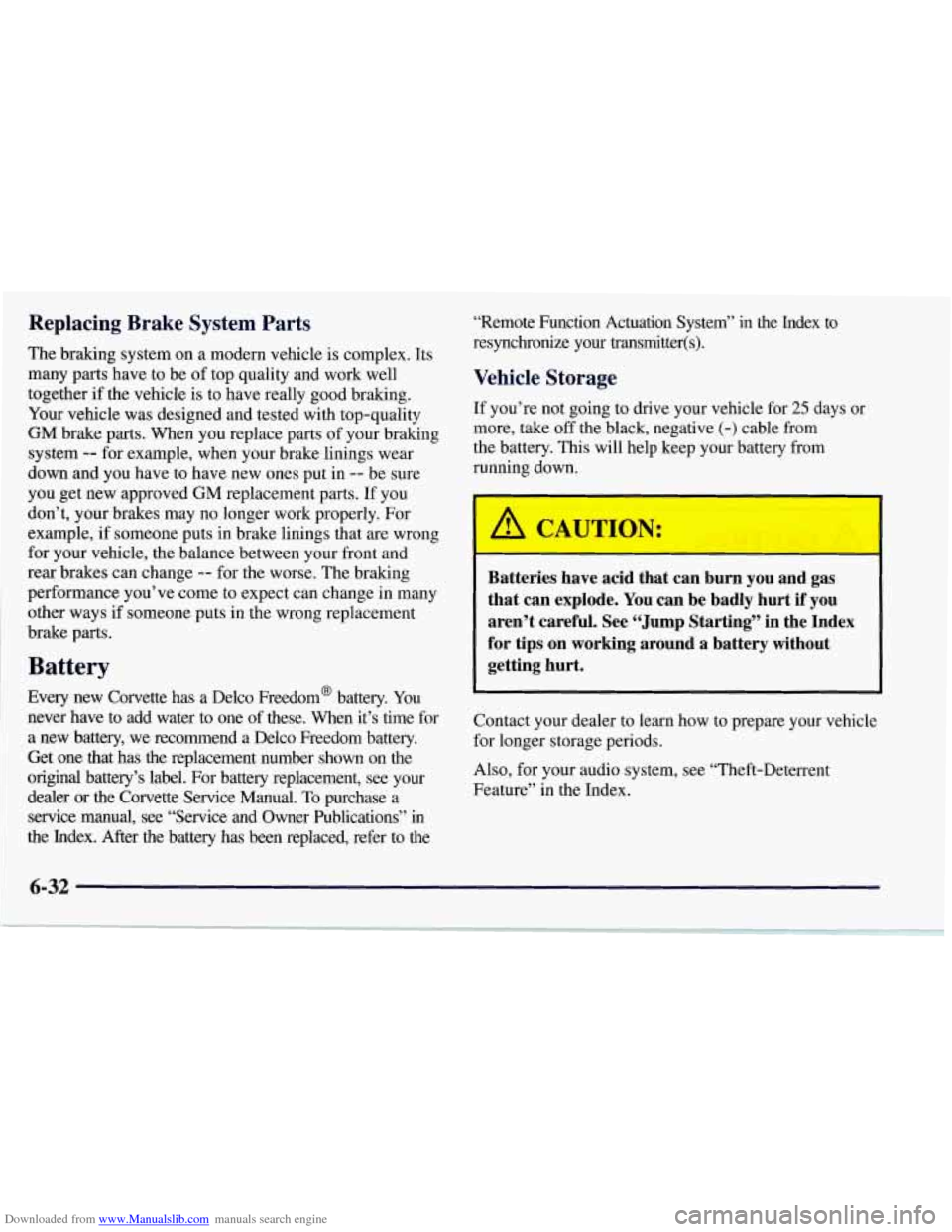
Downloaded from www.Manualslib.com manuals search engine Replacing Brake System Parts
The braking system on a modern vehicle is complex. Its
many parts have to be of top quality and work well
together if the vehicle is to have really good braking.
Your vehicle was designed and tested with top-quality
GM brake parts. When you replace parts of your braking
system
-- for example, when your brake linings wear
down and you have to have new ones put
in -- be sure
you get new approved GM replacement parts. If you
don’t, your brakes may no longer work properly. For
example, if someone puts in brake linings that
are wrong
for your vehicle, the balance between your front and
rear brakes can change
-- for the worse. The braking
performance you’ve come to expect can change in many
other ways if someone puts in the wrong replacement
brake parts.
Battery
Every new Corvette has a Delco Freedom@ battery. You
never have to add water to one of these. When it’s time for
a new battery, we recommend a Delco Freedom battery.
Get one that has the replacement number shown on the
original battery’s label. For battery replacement, see your
dealer or the Corvette Service Manual. To purchase
a
service manual, see “Service and Owner Publications” in
the Index. After the battery has been replaced, refer to the “Remote Function Actuation System” in
the Index to
resynchronize your transmitter(s).
Vehicle Storage
If you’re not going to drive your vehicle for 25 days or
more, take
off the black, negative (-) cable from
the battery.
This will help keep your battery from
running down.
Batteries have acid that can burn you and gas
that can explode. You can be badly hurt
if you
aren’t careful. See “Jump Starting” in the Index
for tips
on working around a battery without
getting hurt.
Contact your dealer to learn how to prepare your vehicle
for longer storage periods.
Also, for your audio system, see “Theft-Deterrent
Feature” in the Index.
6-32
Page 284 of 356
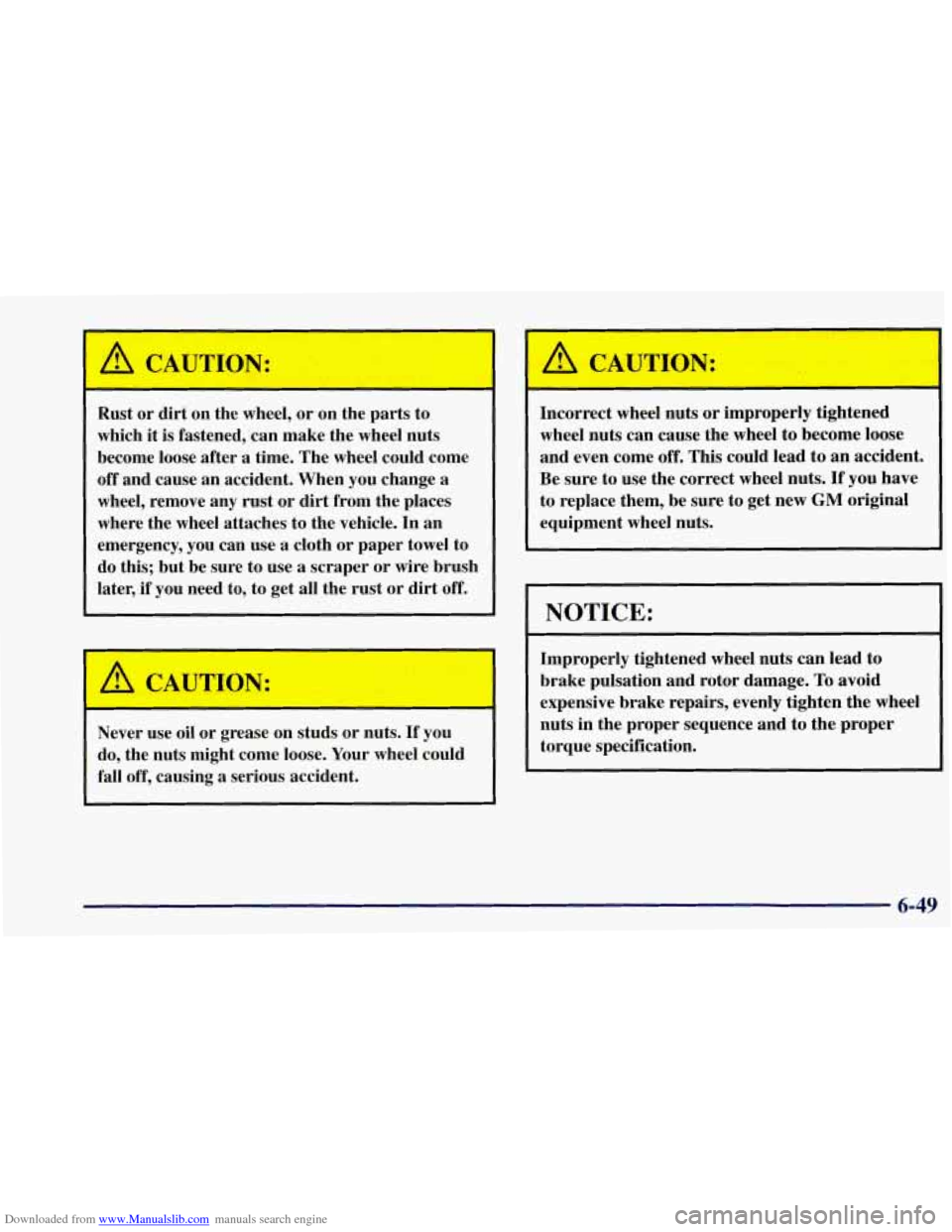
Downloaded from www.Manualslib.com manuals search engine A CAUTION:
I
Rust or dirt on the wheel, or on the parts to
which it is fastened, can make the wheel nuts
become loose after
a time. The wheel could come
off and cause an accident. When you change
a
wheel, remove any rust or dirt from the places
where the wheel attaches to the vehicle. In an
emergency, you can use
a cloth or paper towel to
do this; but be sure to use
a scraper or wire brush
later, if you need to, to get all the rust or dirt off.
Never use oil or grease on studs or nuts.
If you
do, the nuts might come loose. Your wheel could
fall off, causing a serious accident.
~
A CAUTION:
Incorrect wheel nuts or improperly tightened
wheel nuts can cause the wheel to become loose
and even come off. This could lead to an accident.
Be sure to use the correct wheel nuts. If you have
to replace them, be sure to get new
GM original
equipment wheel nuts.
NOTICE:
Improperly tightened wheel nuts can lead to
brake pulsation and rotor damage. To avoid
expensive brake repairs, evenly tighten the wheel
nuts in the proper sequence and to the proper torque specification.
6-49
Page 337 of 356
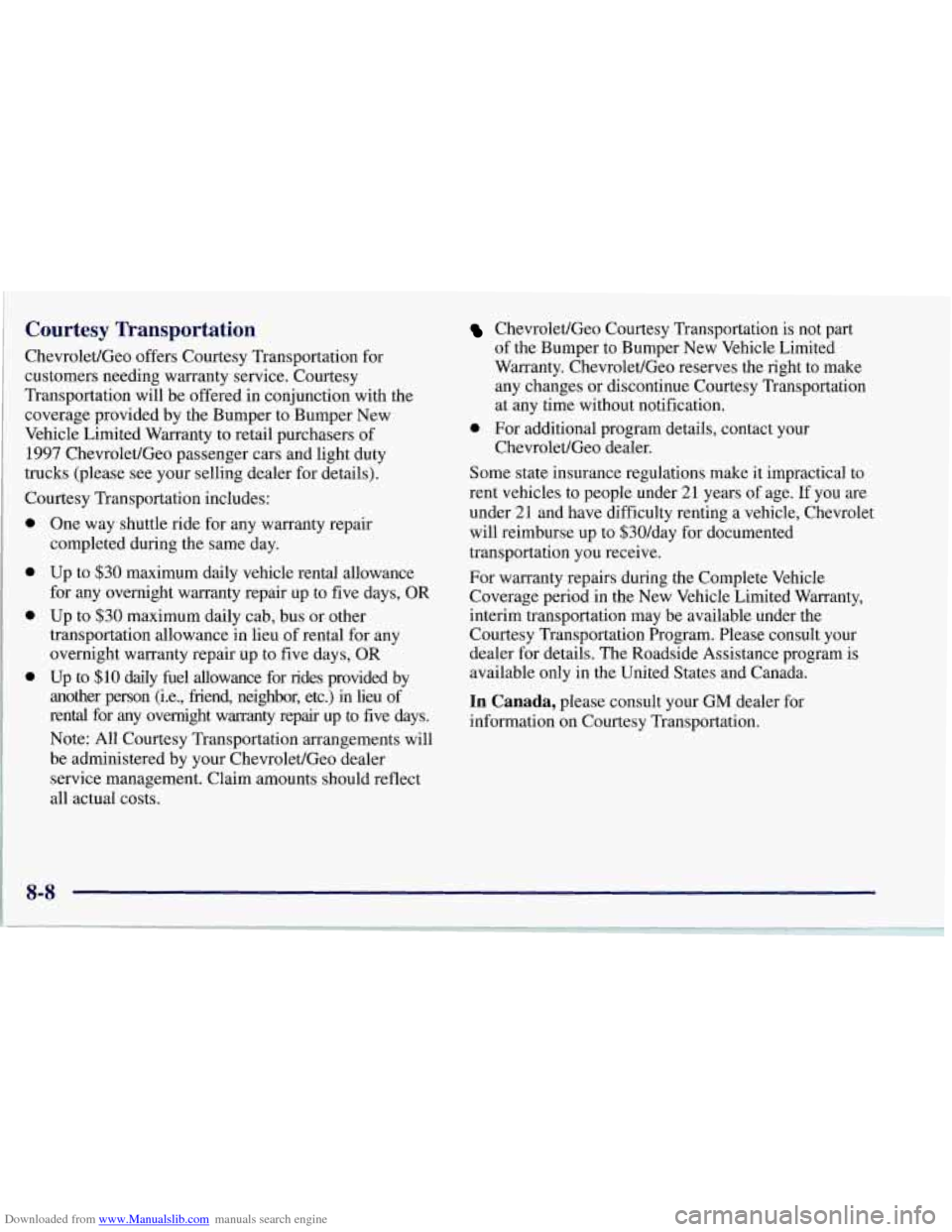
Downloaded from www.Manualslib.com manuals search engine Courtesy Transportation
Chevrolet/Geo offers Courtesy Transportation for
customers needing warranty service. Courtesy
Transportation will be offered in conjunction with the
coverage provided by the Bumper to Bumper New
Vehicle Limited Warranty to retail purchasers of
1997 ChevroletlGeo passenger cars and light duty
trucks (please see your selling dealer for details).
Courtesy Transportation includes:
0
0
a
a
One way shuttle ride for any warranty repair
completed during the same day.
Up to
$30 maximum daily vehicle rental allowance
for any overnight warranty repair up to five days, OR
Up to $30 maximum daily cab, bus or other
transportation allowance in lieu of rental for any
overnight warranty repair up to five days,
OR
Up to $10 daily fuel allowance for rides provided by
another person (i.e., friend, neighbor, etc.) in lieu of
rental for any overnight warranty repair up to five days.
Note: All Courtesy Transportation arrangements will
be administered by your ChevroletIGeo dealer
service management. Claim amounts should reflect
all actual costs.
ChevroletIGeo Courtesy Transportation is not part
of the Bumper to Bumper New Vehicle Limited
Warranty. ChevroletIGeo reserves the right to make
any changes or discontinue Courtesy Transportation
at any time without notification.
Chevrolet/Geo dealer.
0 For additional program details, contact your
Some state insurance regulations make it impractical to
rent vehicles to people under
21 years of age. If you are
under
21 and have difficulty renting a vehicle, Chevrolet
will reimburse up to $30/day for documented
transportation you receive.
For warranty repairs during the Complete Vehicle
Coverage period in the New Vehicle Limited Warranty,
interim transportation may be available under the
Courtesy Transportation Program. Please consult your
dealer for details. The Roadside Assistance program is
available only in the United States and Canada.
In Canada, please consult your GM dealer for
information on Courtesy Transportation.
Page 342 of 356
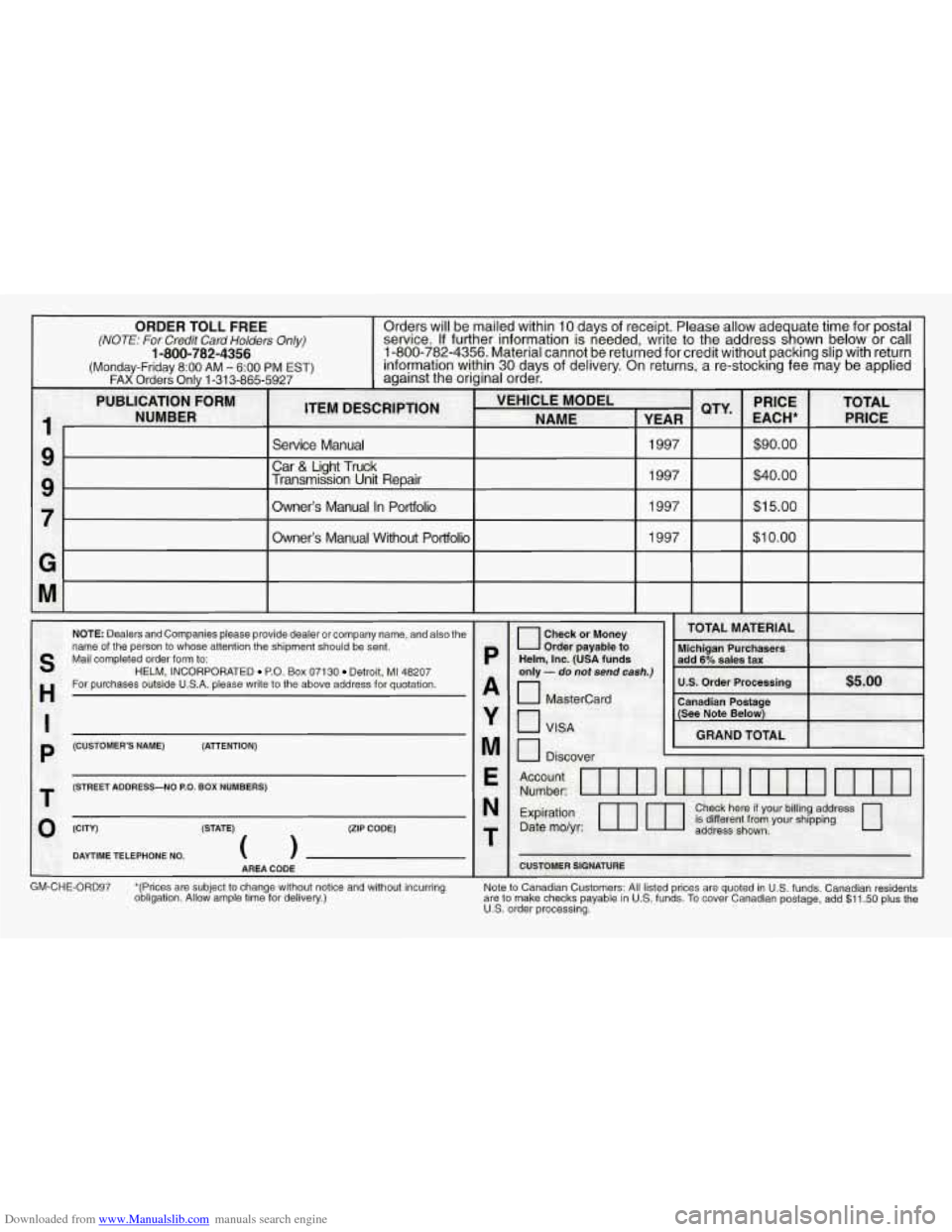
Downloaded from www.Manualslib.com manuals search engine r
ORDER TOLL FREE (NOTE: For Credit Card Holders Only)
1-800-782-4356 (Mondav-Fridav 8:OO AM - 6:OO PM EST)
NOTE: Dealers and Companies please provide dealer or company name, and also the
name of the person to whose attention the shipment should be sent. s Mail completed order form to: HELM, INCORPORATED P.O. Box 07130 Detroit, MI 48207
H
I
For purchases outside U.S.A. please write to the above address for quotation.
p (CUSTOMER’S NAME) (ATTENTION)
IT
(STREET ADDRESS-NO P.O. BOX NUMBERS)
0 (CITY) (STATE) (ZIP CODE)
DAYTIME TELEPHONE NO.
0
I AREA CODE
GM-CHE-ORD97 *(Prices are subject to change without notice and without incurring
obligation. Allow ample time for delivery.)
CUSTOMER SIGNATURE
Note to Canadian Customers: All listed prices are quoted in US. funds. Canadian residents
are to make checks payable in U.S. funds. To cover Canadian postage, add $11.50 plus the
US. order processing.
Page 346 of 356
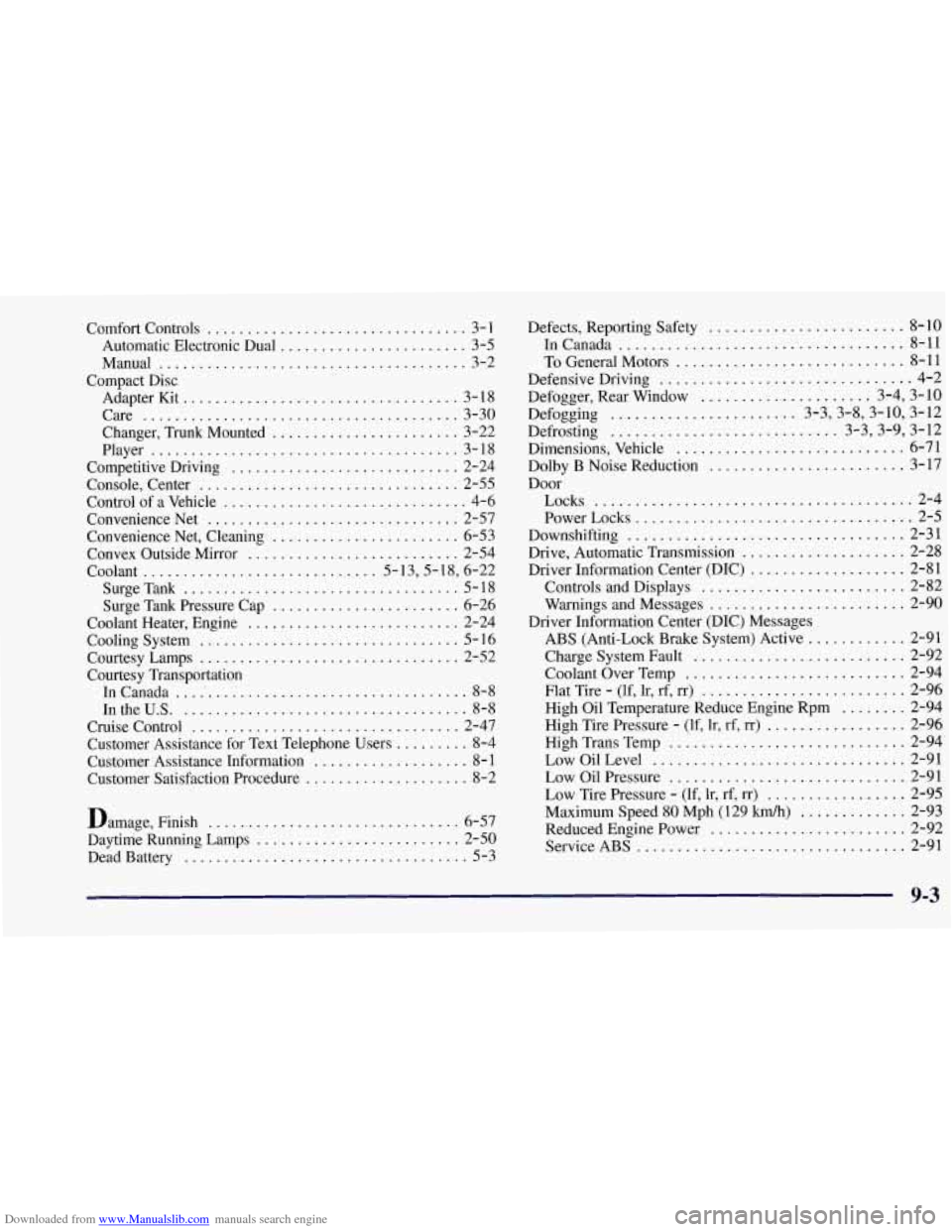
Downloaded from www.Manualslib.com manuals search engine Comfort Controls ................................ 3- 1
Automatic Electronic Dual ....................... 3-5
Manual
...................................... 3-2
Adapter Kit
.................................. 3-18
Care
....................................... 3-30
Changer, Trunk Mounted
....................... 3-22
Player
...................................... 3-18
Competitive Driving ............................ 2-24
Console, Center
................................ 2-55
Control of a Vehicle
.............................. 4-6
Convenience Net
............................... 2-57
Convenience Net, Cleaning
....................... 6-53
Convex Outside Mirror
.......................... 2-54
Coolant
............................. 5-13,5-18, 6-22
SurgeTank
.................................. 5-18
Surge Tank Pressure Cap
....................... 6-26
Coolant Heater, Engine
.......................... 2-24
Cooling System
................................ 5- 16
CourtesyLamps
................................ 2-52
Courtesy Transportation
In Canada
..................................... 8-8
1ntheU.S. ................................... 8-8
Cruise Control ................................. 2-47
Customer Assistance for Text Telephone Users
......... 8-4
Customer Assistance Information
................... 8- 1
Customer Satisfaction Procedure .................... 8-2
Compact Disc
Damage. Finish
............................... 6-57
Daytime Running Lamps
......................... 2-50
Dead Battery
................................... 5-3 Defects. Reporting Safety
........................ 8-10
InCanada
................................... 8-11
To General Motors ............................ 8-11
Defensive Driving
............................... 4-2
Defogger. Rear Window
..................... 3.4. 3.10
Defogging
....................... 3.3.3.8.3.10. 3.12
Defrosting
............................ 3.3.3.9. 3.12
Dimensions. Vehicle
............................ 6-71
Dolby
B Noise Reduction ........................ 3-17
Door Locks
....................................... 2-4
PowerLocks
.................................. 2-5
Downshifting
.................................. 2-31
Drive, Automatic Transmission
.................... 2-28
Driver Information Center (DIC)
................... 2-81
Controls and Displays
......................... 2-82
Warnings and Messages
........................ 2-90
ABS (Anti-Lock Brake System) Active
............ 2-91
Charge System Fault
.......................... 2-92
Coolant Over Temp
........................... 2-94
Flat Tire
- (If, lr, rf, rr) ......................... 2-96
High Oil Temperature Reduce Engine Rpm
........ 2-94
High Tire Pressure
- (If. Ir, rf. IT) ................. 2-96
High Trans Temp
............................. 2-94
LowOilLevel
............................... 2-91
Low Oil Pressure
............................. 2-91
Low Tire Pressure
- (If, lr. rf, rr) ................. 2-95
Maximum Speed 80 Mph (129
Mh) ............. 2-93
Reduced Engine Power
........................ 2-92
Service ABS
................................. 2-91
Driver Information Center
(DIC) Messages
9-3